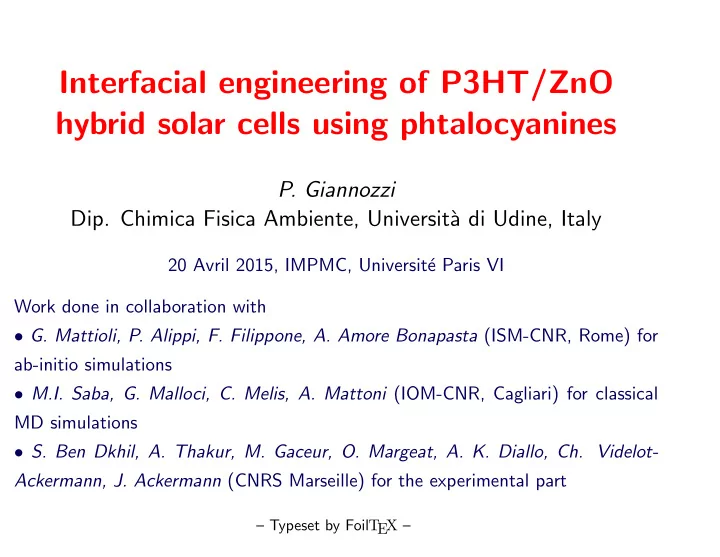

Interfacial engineering of P3HT/ZnO hybrid solar cells using phtalocyanines P. Giannozzi Dip. Chimica Fisica Ambiente, Universit` a di Udine, Italy 20 Avril 2015, IMPMC, Universit´ e Paris VI Work done in collaboration with • G. Mattioli, P. Alippi, F. Filippone, A. Amore Bonapasta (ISM-CNR, Rome) for ab-initio simulations • M.I. Saba, G. Malloci, C. Melis, A. Mattoni (IOM-CNR, Cagliari) for classical MD simulations • S. Ben Dkhil, A. Thakur, M. Gaceur, O. Margeat, A. K. Diallo, Ch. Videlot- Ackermann, J. Ackermann (CNRS Marseille) for the experimental part – Typeset by Foil T EX –
New hybrid materials for solar cells Hybrid photovoltaic cells: organic molecule or π − conjugated polymer acting as dye (light absorber) and electron donor, on inorganic substrate acting as acceptor. Hold great promises for the realization of cheap and high-yield solar cells. Good dye and donor candidates: (on the right) polymers such as P3HT, poly(3-hexylthiophene-2,5-diyl); Phtalocyanines (Pc) (on the left, ZnPc) Good substrate candidate: metal oxide nanoparticles, typically TiO 2 , with ZnO emerging as alternative material (both are cheap and nontoxic). ZnO is a high-mobility, wide-gap (3.4 eV) material with wurtzite structure. On the right, the (1010) surface of ZnO, the most common surface in ZnO nanoparticles
Model systems In the past, both P3HT/ZnO and ZnPc/ZnO hybrid systems have been proposed and studied. In this work, the idea is to increase the efficiency of such systems by introducing ternary heterostructures such as P3HT/ZnPc/ZnO. Hopefully, they may provide better efficiency via • Increased optical absorption over a wider spectrum, and • Reduced electron-hole recombination Problems for a first-principle theoretical approach: • Very large supercells (hundreds of atoms) even for simplest model structures (few layers of a surface, or a very small nanoparticle): big calculations! • Hard problem in a Density-Functional Theory (DFT) framework, due to – Long-range dispersion (van der Waals) interactions – Strongly correlated 3d states in Zn (correct energy level alignement is crucial) – Need for reliable (or not too wrong) excited states: band gap, optical spectra
Theoretical Methods Theoretical solutions adopted: • Model Potential Molecular Dynamics allows relatively quick selection of potentially stable structures, followed by Density-Functional Theory refinements • Usage of advanced DFT functionals: – DFT+U corrects the worst failures of DFT in correlated materials – vdw-DF allows to include van der Waals forces – tests with hybrid functionals to gain confidence in the results • Usage of Time-Dependent DF(P)T for calculation of optical spectra (good for molecules, much less so for solids) DFT calculations performed on HPC machines (mostly on IBM-SP6 machine at Cineca) using the parallel algorithms of the QUANTUM Espresso distribution.
Model P3HT/ZnPc/ZnO: structure, stability ZnPc on (1010) ZnO surface forms stable layer ( E b = 2 . 2 eV/molecule) 8-unit P3HT binds with E b = 0 . 6 eV/unit to ZnPc/ZnO (vs 0 . 4 eV/unit to ZnO)
Electronic states, energies CS (charge-separated) states: e − is in ZnO CBM (Conduction Band Minimum), h + is in molecular HOMO. The ZnPc layer raises P3HT LUMO to a more favorable position for e − transfer to ZnPc and ZnO, improving charge separation at interface
Electronic states, localization in space Electron-hole recombination made less likely by ZnPc layer: e − and h + densities in charge-separated state are more spacially separated and have smaller overlap
Simulated TD-DFPT optical spectra A. ZnPc/ZnO absorption: split Q-bands at 1.7 and 1.9 eV, Soret band at 3.1 eV. B. P3HT/ZnPc/ZnO: superposition of ZnPc/ZnO peaks and of the blue-shifted (2.3 eV) peak of P3HT. C. 4-unit P3HT on ZnO: absorption peak at 2.15 eV. (Contribution from ZnO substrate is subtracted out)
Experiments: optical spectra, ZnPc on ZnO ZnPc on glass: two peaks (Q bands) at 622 nm and 711 nm ZnPc on ZnO: additional peaks due to molecule-substrate interactions appear at 674 nm (blue arrow) and at 742 nm (light blue arrow) (two different ZnPc layer thickness, 4 nm and 15 nm, yield similar results)
Experiments: optical spectra, P3HT/ZnPc/ZnO ZnPc film thickness: blue dots 4 nm, black dots 15 nm. Up: The spectrum of P3HT/ZnPc/ZnO exhibits absorption peaks of P3HT and of ZnPc, plus the new optical features of ZnPc/ZnO interface. Down: External Quantum Efficiency (EQE) shows that the new band at 674 nm contributes additional photocurrent.
Experiments: current density-voltage curves Measured performances: PCE V oc J sc no ZnPc 0.71 0.17 0.06 4 nm ZnPc 0.61 0.26 0.09 15 nm ZnPc 0.60 0.07 0.07 Open-circuit voltage V oc in V, short-circuit density current J sc in mA/cm 2 , Power Conversion Efficiency (PCE) in %
Experiments: transient open circuit voltage decay Blue: P3HT/ZnPc/ZnO, Red: P3HT/ZnO. Illumination is suppressed with circuit open (no current flowing) and the decay time of carriers is measured. Carrier lifetime as a function of the open circuit voltage, in the region V oc < 0 . 48 V, is a measure of recombination in the heterostructure region, showing improved lifetime for P3HT/ZnPc/ZnO.
Discussion and conclusions Theoretical predictions on the ternary P3HT/ZnPc/ZnO system: • The system is thermodynamically stable • Light absorption from both P3HT and ZnPc covering a wide spectrum • Increased charge separation due to ZnPc layer reduces recombination • The P3HT HOMO is shifted by the ZnPc layer to higher energies, leading to a reduction of V oc of ∼ 0 . 1 V. Experimental data on actual samples, produced and measured at CNRS Marseille, confirm all of the above findings.
Recommend
More recommend